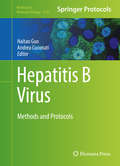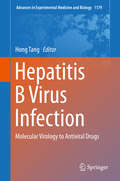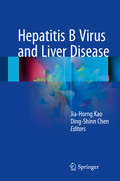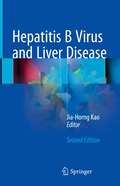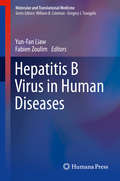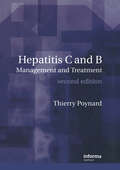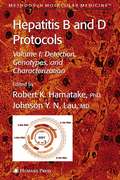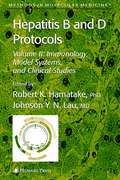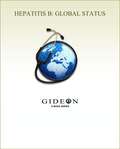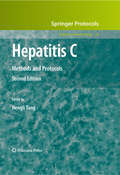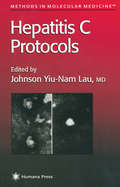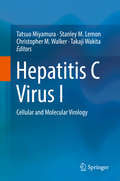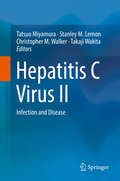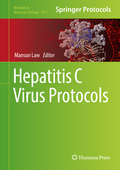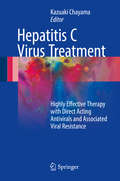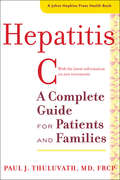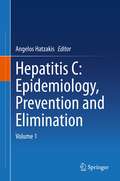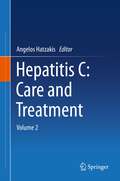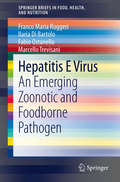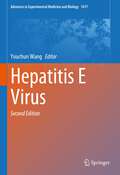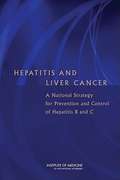- Table View
- List View
Hepatitis B Virus
by Haitao Guo Andrea CuconatiThis volume serves as a reference for the dissemination of advances made in the study of Hepatitis B Virus (HBV). Hepatitis B Virus: Methods and Protocols details protocols and techniques ranging from cell culture studies to in vivo and clinical immunology. The chapters in this book discuss treatments of in vitro infection systems, analysis and quantification of cccDNA and its mutations; in vitro polymerase activity assays; cellular trafficking of core proteins; intracellular calcium metabolism; detection, cloning, and sequencing of HBV markers; and new strategies aimed at exploiting new mechanisms for drug discovery. The book also covers classical methods for resolution of extracellular viral particles by native gel electrophoresis, and methods for detecting HBV antigens in drug discovery. Written in the highly successful Methods in Molecular Biology series format, chapters include introductions to their respective topics, lists of the necessary materials and reagents, step-by-step, readily reproducible laboratory protocols, and tips on troubleshooting and avoiding known pitfalls. Cutting-edge and comprehensive, Hepatitis B Virus: Methods and Protocols is a valuable tool for researchers to use toward their advanced studies in HBV.
Hepatitis B Virus Infection: Molecular Virology to Antiviral Drugs (Advances in Experimental Medicine and Biology #1179)
by Hong TangThis volume provides a state-of-the-art review of the key aspects of HBV. It covers our current understanding of the HBV genome and lifecycle, liver-enriched factors in the regulation of HBV transcription and translation, HBV protein structures and biological functions, and the immunology and pathogenesis of HBV. It also provides an update on cell and animal models, as well as molecular approaches. The respective chapters also cover the clinical management of hepatitis B and discuss future research directions, in particular, the identification of molecular targets for pharmacological intervention. Given its scope, the book offers a valuable resource for students, researchers, clinicians, and health practitioners in the fields of virology, infectious disease, public health etc. Dr Hong Tang is a Professor and Director of the Center of Infectious Diseases, West China Hospital of Sichuan University.
Hepatitis B Virus and Liver Disease
by Jia-Horng Kao Ding-Shinn ChenThis book provides a comprehensive, state-of-the art review of HBV infection and liver disease. It discusses new data on basic and translational medicine, including the viral life cycle, the immunopathogenesis of virus-induced chronic hepatitis, viral and host genetic factors affecting disease progression, and the mechanism of virus-induced hepatocarcinogenesis, as well as their potential applications in daily clinical practice. The clinical aspects of chronic HBV infection are examined in chapters on the global epidemiology, efficacy of HBV vaccination, natural history, co-infections with HCV, HDV or HIV, and management of special populations including children, pregnant women and patients undergoing immunosuppressive therapy. Further, it describes the advances and perspectives in the development of novel antiviral treatments as possible cures for HBV infection. The book is a valuable resource for medical students, physicians, and researchers who are interested in managem ent of patients with chronic HBV infection and investigation of HBV infection.
Hepatitis B Virus and Liver Disease
by Jia-Horng KaoThis book provides a comprehensive, state-of-the art review of HBV infection and liver disease. It discusses new data on basic and translational medicine, including the viral life cycle, the immunopathogenesis of virus-induced chronic hepatitis, viral and host genetic factors affecting disease progression, and the mechanism of virus-induced hepatocarcinogenesis, as well as their potential applications in daily clinical practice. The clinical aspects of chronic HBV infection are examined in chapters on the global epidemiology, efficacy of HBV vaccination, natural history, novel biomarkers, co-infections with HCV, HDV or HIV, and management of special populations including children, pregnant women and patients undergoing immunosuppressive therapy. Further, it describes the advances and perspectives in the development of novel antiviral treatments for possible functional cure of HBV infection.In this second edition, authors provides recent updates in epidemiology, biomarkers, antivirus therapy, and novel therapy for functional cure of chronic hepatitis B virus infection.The book is a valuable resource for medical students, physicians, and researchers who are interested in management of patients with chronic HBV infection and investigation HBV infection.
Hepatitis B Virus in Human Diseases
by Yun-Fan Liaw Fabien ZoulimThis text provides a comprehensive, state-of-the art review of this field, and will serve as a valuable resource for students, clinicians, and researchers with an interest in hepatitis B. The book reviews new data about basic and translational science including the viral life cycle, the immunopathogenesis of virus induced chronic hepatitis, the mechanism of virus induced liver cancer, and their potential applications for the clinical management of patients. The clinical aspects of this chronic viral infection are reviewed in detail with important chapters on the global epidemiology, the natural history of the disease, co-infections with its satellite virus HDV or HIV, and management of special patient populations. A major emphasis is made on the management of antiviral therapy and the recent international guidelines for the treatment of hepatitis B. Finally, the book reviews the current state of the art regarding immunoprophylaxis to prevent the spread of the virus and its major clinical consequences. The new advances and perspectives in the development of improved antiviral treatments are also discussed. Hepatitis B Virus in Human Diseases will serve as a very useful resource for students, physicians and researchers dealing with, and interested in, this challenging chronic viral infection. It will provide a concise yet comprehensive summary of the current status of the field that will help guide patient management and stimulate investigative efforts. All chapters are written by experts in their fields and include the most up to date scientific and clinical information.
Hepatitis B and C: Management and Treatment
by Thierry PoynardChronic hepatitis B and C affect 520 million people worldwide, and are a major cause of chronic liver disease and of mortality, despite the efficacy of the vaccine. Hepatitis B and C: Management and Treatment second edition provides a practical explanation of the natural history and management of the disease, and examines the benefits of the most recent drugs, and their effects, whether used in isolation or as part of a combination therapy. This second edition expands the coverage of treatment of various difficult-to-treat patients and will be a welcome guide to the physician in both clinical decision-making and in explaining the benefits and side-effects to the patient.
Hepatitis B and D Protocols, Volume 1: Detection, Genotypes, and Characterization
by Johnson Y. Lau Robert K. HamatakeDespite the availability of an effective vaccine, there are still 400 million people worldwide who are chronically infected with the hepatitis B and D viruses (HBV and HDV), and more work still needs to be done in all of the key areas of managing the disease. In Hepatitis B and D Protocols, leading investigators and clinicians have joined forces to create a broad-ranging collection of core techniques for the study of HBV and HDV infections and for the development of therapies to treat them. In this first of two volumes Detection, Genotypes, and Characterization, the authors focus on readily reproducible molecular methods for the identification and quantification of viral markers, the detection and impact of viral variants, and the study of the viral life cycle. Each fully tested protocol is described in step-by-step detail by an established expert in the field and includes a background introduction outlining the principle underlying the technique, equipment and reagent lists, and tips on troubleshooting and avoiding known pitfalls. An accompanying second volume, Immunology, Model Systems, and Clinical Studies, contains user-friendly protocols for the study of host immune responses to infection, in vitro and in vivo models of infection, and the development of antivirals.<P><P> Taken together, Hepatitis B and D Protocols, Volume 1: Detection, Genotypes, and Characterization and Volume 2: Immunology, Model Systems, and Clinical Studies offer both new and experienced investigators an encyclopedic collection of powerful tools for studying HBV and HDV infections, as well as an essential resource for finding new therapies to treat chronically infected patients.
Hepatitis B and D Protocols, Volume 2: Immunology, Model Systems, and Clinical Studies
by Johnson Y. Lau Robert K. HamatakeDespite the availability of an effective vaccine, there are still 400 million people worldwide who are chronically infected with the hepatitis B and D viruses (HBV and HDV), and more work still needs to be done in all of the key areas of managing the disease. In Hepatitis B and D Protocols, leading investigators and clinicians have joined forces to create a broad-ranging collection of cutting-edge techniques for the study of HBV and HDV infections and for the development of therapies to treat them. In this second of two volumes, Immunology, Model Systems, and Clinical Studies, the authors focus on protocols for the study of host immune responses to infection, in vitro and in vivo models of infection, and the development of antivirals. Each fully tested protocol is described in step-by-step detail by an established expert in the field and includes a background introduction outlining the principle underlying the technique, equipment and reagent lists, and tips on troubleshooting and avoiding known pitfalls. An accompanying first volume, Detection, Genotypes, and Characterization, contains user-friendly protocols for the identification and quantification of viral markers, the detection and impact of viral variants, and the study of the viral life cycle.<P><P> Taken together, Hepatitis B and D Protocols, Volume 1: Detection, Genotypes, and Characterization and Volume 2: Immunology, Model Systems, and Clinical Studies offer both new and experienced investigators an encyclopedic collection of powerful tools for studying HBV and HDV infections, as well as an essential resource for finding new therapies to treat chronically infected patients.
Hepatitis B: Global Status 2010 edition
by Dr Stephen Berger Gideon InformaticsHepatitis B: Global Status is one in a series of GIDEON ebooks which summarize the status of individual infectious diseases, in every country of the world. Data are based on the GIDEON database (www.gideononline.com) which relies on standard text books, peer-review journals, Health Ministry reports and ProMED, supplemented by an ongoing search of the medical literature. Chapters are arranged alphabetically, by country name. Each section is divided into five subsections. 1. Descriptive epidemiology 2. Summary of clinical features 3. Global status of the disease 4. Status of the disease in a specific country 5. References
Hepatitis C
by Hengli TangWith the development of robust cell-culturing systems capable of Hepatitis C Virus replication and infection, the past decade has witnessed an explosion of innovative research directed at understanding HCV biology in the context of the authentic replicative cycle of the virus. By providing a compilation of cutting-edge research techniques currently in use in HCV labs worldwide, Hepatitis C: Methods and Protocols, Second Edition fully updates the previous edition to reflect this progress which promises to unlock the remaining vital information regarding this human pathogen and its interactions. Written in the highly successful Methods in Molecular BiologyTM series format, chapters include brief introductions to the topics, lists of the necessary materials and reagents, step-by-step, readily reproducible laboratory protocols, and notes on troubleshooting and avoiding known pitfalls. Fully updated and comprehensive, Hepatitis C: Methods and Protocols, Second Edition serves as a valuable reference guide for basic and clinical researchers using HCV as a model and striving to better understand this critical disease.
Hepatitis C Protocols
by Johnson Y. LauJohnson Lau and his expert collaborators present cutting-edge techniques for study of the hepatitis C virus, a disease afflicting over 100 million people worldwide. The methods range from the detection of anti-HCV in serum and HCV in liver tissue to HCV genotypes and the detection and quantification of HCV in serum. In addition to these key protocols, the authoritative contributors also evaluate recombinant proteins in immunological test systems, including the identification of important antigenic epitopes, antibodies, and recombinant antigens. The methods and systems detailed in this book will play a key role in the development of more effective antivirals, in the introduction of vaccines, and in a deeper understanding of viral replication strategies, viron structure, and the mechanisms of viron assembly and release.
Hepatitis C Virus I
by Stanley M. Lemon Tatsuo Miyamura Christopher M. Walker Takaji WakitaThis volume is composed of chapters that review important fundamental aspects of HCV biology and disease pathogenesis including, for example, the discovery and identification of the HCV genome, early virus-cell interactions including identification of various cellular receptors, HCV gene expression studied using the HCV replicon system, identification and characterization of HCV structural- and non-structural HCV proteins, HCV replication in cultured cells, and host factors involved in viral replication. This volume also contains chapters dealing with immunity to HCV infection and pathogenesis. This is particularly important in understanding hepatitis C because HCV infection alone is not cell lytic. Mechanisms underlying the persistent nature of HCV infection are also discussed in these chapters. Many of the authors published articles that were listed among the "top 10 papers" published in the 24 years since HCV was discovered in 1989. Their citations are above 1,000 (Web of Science). The authors describe the background and significance of their contributions to the field in the context of findings from other research groups.
Hepatitis C Virus II
by Stanley M. Lemon Tatsuo Miyamura Christopher M. Walker Takaji WakitaThis book helps scientists, clinicians and otherinterested individuals understand recent clinical advances and challenges forthe future. It covers many basic aspects of the pathogenesis of chronic hepatitisC, HCV infections in particular populations, approaches to therapy, andprevention and control of HCV Infection. The book provides a succinct review ofthe large amount of data generated by multiple groups over the past two decadesthat has revealed the natural history of HCV infection. Similarly, itsummarizes current understanding of the origins of HCV-associatedhepatocellular carcinoma, cirrhosis and hepatic fibrosis. Extra-hepaticmanifestation and metabolic disorders related to HCV infection are described. In this volume, these clinically important aspects of HCV infection arecomprehensively described. Highlights are description of newly developed direct- acting antivirals. The authors represent a worldwidedistribution of leaders in the field reflecting the global nature of HCVinfection. Based on recent data concerning the genetic- and geographicaldiversity of HCV, and increased global disease burden of HCV infection, challenges for global control of HCV infections are described.
Hepatitis C Virus Protocols (Methods in Molecular Biology #1911)
by Mansun LawThis volume details the most updated concepts and experimental protocols developed by leading researchers in the field. Chapters guide readers through methods on bioinformatics tools, hepatitis c virus(HCV) cloning, culture, and purification, HCV life cycle, host immune responses, and small animal models. Written in the highly successful Methods in Molecular Biology series format, chapters include introductions to their respective topics, lists of the necessary materials and reagents, step-by-step, readily reproducible laboratory protocols, and tips on troubleshooting and avoiding known pitfalls.Authoritative and cutting-edge, Hepatitis C Virus Protocols aims to ensure successful results in the further study of this vital field.
Hepatitis C Virus Treatment
by Kazuaki ChayamaThis book introduces readers to Direct Acting Antiviral (DAAs) agents, newly developed drugs to treat chronic hepatitis C virus infection, which have an excellent anti-viral effect on virus replication. These drugs have been developed to enhance the effect of interferon and ribavirin, as the resistant strains against each drug have been described both in vitro and in vivo and the existences of naturally occurring variants have been reported. However, since the combination of different classes of DAAs is sufficient to completely eradicate the virus without the need for interferon or ribavirin, the current treatment regimen does not include interferon. Ribavirin is used in combination with sofosbuvir, a potent polymerase inhibitor, to enhance its antiviral effects. Hepatitis C Virus Treatment offers readers a comprehensive guide to hepatitis C; describing the resistance profiles against these drugs and shedding light on the difficulties involved in DAA therapy and the direction of future treatments, it will equip doctors to understand the essentials of treating the disease. It also describes in detail new and innovative DAA treatments, the effects of the agents, and the characteristics of resistance, providing cutting-edge information not only for hepatologists, but also for researchers, clinical residents, and medical students.
Hepatitis C Virus and Liver Transplantation
by Marina BerenguerHepatitis C Virus and Liver Transplantation is designed to provide a comprehensive and state-of-the-art overview of the major issues specific to the field of liver transplantation and hepatitis C virus infection. The sections of the book have been structured to review the overall scope of issues of recurrent hepatitis C in different complex settings, including retransplantation, HIV-coinfected patients or in the setting of suboptimal graft donors. This book provides up-to-date information on the application of new therapies to the field of liver transplantation. It provides the most recent data on their efficacy, the management of side effects, as well as the potential interactions and specific problems associated with their use in the transplant setting. Finally, an appraisal of the risks and benefits of using organs from anti-HCV positive donors is presented. This book provides concise and actual materials for several important topics that are simply not adequately covered by current available literature. Hepatitis C Virus and Liver Transplantation will provide a unique and valuable resource in the field of liver transplantation and will be of great value to Hepatologists, Transplant and Abdominal Surgeons, Oncologists, as well as Fellows and Residents training in these fields.
Hepatitis C Virus: From Molecular Virology To Antiviral Therapy (Current Topics in Microbiology and Immunology #369)
by Ralf BartenschlagerHepatitis C virus (HCV), a major causative agent of chronic liver disease, is spread throughout the world and around 170 million people are persistently infected. In this volume, world-leading experts in the field of HCV research have compiled the most recent scientific advances to provide a comprehensive and very timely overview of the various facets of HCV. The book starts with a discussion of the possible origin of HCV and its spread among the human population. The focus of the subsequent chapters is on available cell culture and in vivo models before shifting to the molecular and cellular principles underlying the viral replication cycle. These chapters are complemented by insightful descriptions of the innate and adaptive immune responses to HCV as well as the virus-associated pathogenesis. Finally, the development of antiviral therapies, which is closely linked with progress in basic research, and the implementation of those therapies into present and future daily clinical practice are highlighted.
Hepatitis C Virus: From Molecular Virology to Antiviral Therapy
by Ralf BartenschlagerHepatitis C virus (HCV), a major causative agent of chronic liver disease, is spread throughout the world and around 170 million people are persistently infected. In this volume, world-leading experts in the field of HCV research have compiled the most recent scientific advances to provide a comprehensive and very timely overview of the various facets of HCV. The book starts with a discussion of the possible origin of HCV and its spread among the human population. The focus of the subsequent chapters is on available cell culture and in vivo models before shifting to the molecular and cellular principles underlying the viral replication cycle. These chapters are complemented by insightful descriptions of the innate and adaptive immune responses to HCV as well as the virus-associated pathogenesis. Finally, the development of antiviral therapies, which is closely linked with progress in basic research, and the implementation of those therapies into present and future daily clinical practice are highlighted.
Hepatitis C: A Complete Guide for Patients and Families (A Johns Hopkins Press Health Book)
by Paul J. ThuluvathVital and hopeful information for people suffering from hepatitis C, an often chronic—and sometimes deadly—disease of the liver.The liver is the body's workhorse. It makes proteins and bile, processes fats, and detoxifies drugs and alcohol. The liver is a resilient organ, but it is susceptible to damage from a number of sources, including viral infections. Such infections cause inflammation of the liver, called hepatitis. This book is a comprehensive guide to hepatitis C, which affects about 3 percent of the world's population—3 to 4 million people in the United States alone. Some people with acute hepatitis C infection will be cured without any treatment, but when hepatitis C becomes chronic it may cause cirrhosis, liver cancer, and death.Hepatitis C is transmitted from an infected person to an uninfected person by sharing drug-injecting equipment, snorting cocaine, having sex, or getting a blood transfusion or organ transplant. It can be spread by getting a tattoo with unsterile equipment. In rare cases, women with hepatitis C transmit the virus to their infants.World-renowned gastroenterologist and liver specialist Dr. Paul J. Thuluvath provides detailed information about the disease and its diagnosis and management, including dramatically improved treatments that have recently emerged. Dr. Thuluvath answers common and uncommon questions about hepatitis C and liver disease, including How is hepatitis C spread? Who should be tested—and what tests diagnose hepatitis C and other liver diseases? What are the symptoms of acute liver disease? What are the symptoms and complications of chronic liver disease? What are the complications of cirrhosis (scarring of the liver)? How does hepatitis C affect other organs in the body? What treatment options are available, and what side effects might they have? How is early liver cancer diagnosed and treated? When is liver transplantation needed, and how does it work? Dr. Thuluvath provides the latest information on new interferon-free regimens, which have shown a cure rate of more than 90% in people with specific genotypes—and which avoid the distressing side effects of interferon therapy. He discusses hepatitis C in children as well as complementary and alternative medicine. Published while revolutionary changes are taking place in the treatment of hepatitis C, this authoritative guide will become the preferred reference for people with hepatitis C and their families.
Hepatitis C: Volume 1
by Angelos HatzakisThis volume focuses on epidemiology, genetic diversity and global distribution of Hepatitis C, as well as laboratory diagnosis. Furthermore, the book explores the natural history of the virus and discusses international elimination strategies. The two volume work on Hepatitis C introduces to the topic by reviewing virology, diagnosis, epidemiology, prevention and elimination of HCV. The book provides a valuable source at full length for researchers and clinicians working on Hepatitis C.
Hepatitis C: Volume 2
by Angelos HatzakisThis volume provides the reader with a detailed overview of the current state-of-the art approach of Hepatitis C management. It reviews the course of action in handling of chronic Hepatitis C patients with various HCV genotypes and treats special cases such as acute hepatitis, transplant and renal patients as well as people who inject drugs. The two volume work on Hepatitis C introduces to the topic by reviewing virology, diagnosis, epidemiology, prevention, management and elimination of HCV. The book provides a valuable source at full length for researchers and clinicians working on Hepatitis C.
Hepatitis E Virus
by Fabio Ostanello Franco Maria Ruggeri Ilaria Di Bartolo Marcello TrevisaniHepatitis E (HEV) is a viral infectious disease that infects humans and domestic, wild, and synanthropic animals alike. In developing countries, the disease often presents as an epidemic, transmitted primarily through the fecal-oral route. In recent years, sporadic cases have also been documented in industrial countries, including Europe. The identification and characterization of animal strains of HEV from pigs, wild boar, and deer, and the demonstrated ability of cross-species infection by these animal strains raise potential public health concerns for foodborne and zoonotic transmission of the virus. This Brief will provide a thorough overview of HEV. It will discuss the epidemiology and pathogenesis of the virus in both humans and animals, review detection methods, and provide methods for its control and prevention.
Hepatitis E Virus
by Youchun WangThis book systematically and comprehensively discusses the biological, epidemiological and clinical characteristics of the hepatitis E virus (HEV). It presents current knowledge of HEV and explores experimental methods, treatment and prevention of HEV. First identified in the 1980s and cloned in 1990, HEV is the causative agent of Hepatitis E, which mainly occurs in developing regions, such as Southeast Asia, Middle East and Africa, and significantly affects the health of the people in these areas. It is estimated that a third of the world's population has been infected with HEV, which is transmitted via the fecal-oral route and can infect both human and animals. The book provides an overview of HEV from benchside to bedside. It is a valuable resource for researchers in the field and those in the pharmaceutical industry developing HEV vaccines, as well as physicians involved in identifying and treating those infected with the virus.
Hepatitis E Virus (Advances in Experimental Medicine and Biology #1417)
by Youchun WangThis book systematically and comprehensively discusses the biological, epidemiological, and clinical characteristics of the hepatitis E virus (HEV). It presents current knowledge of HEV and explores experimental methods, treatment, and prevention of HEV. First identified in the 1980s and cloned in 1990, HEV is the causative agent of hepatitis E, which mainly occurs in developing regions, such as Southeast Asia, the Middle East, and Africa, and significantly affects the health of the people in these areas. It is estimated that a third of the world’s population has been infected with HEV, which is transmitted via the fecal-oral route and can infect both humans and animals. In the second edition, new chapters are added to demonstrate the lifecycle, morphogenesis, and stem cell culture of hepatitis E virus. Although research on hepatitis E virus has made progress recently, there are still some problems that have not been solved. Those problems are discussed in this edition, which would be helpful for researchers to understand the problems on hepatitis E virus that they have faced. Meanwhile, the epidemiology, transmission, genetic evolution, animal models, treatment, and others in the related chapters of the first version were also updated according to the most recent research progress. The book provides an overview of HEV from benchside to bedside. It is a valuable resource for researchers in the field and those in the pharmaceutical industry developing HEV vaccines, as well as physicians involved in identifying and treating those infected with the virus.
Hepatitis and Liver Cancer: A National Strategy for Prevention and Control of Hepatitis B and C
by Institute of Medicine of the National AcademiesThe global epidemic of hepatitis B and C is a serious public health problem. Hepatitis B and C are the major causes of chronic liver disease and liver cancer in the world. In the next 10 years, 150,000 people in the United States will die from liver disease or liver cancer associated with chronic hepatitis B virus (HBV) or hepatitis C virus (HCV) infections. Today, between 800,000 and 1.4 million people in the United States have chronic hepatitis B and between 2.7 and 3.9 million have chronic hepatitis C. People most at risk for hepatitis B and C often are the least likely to have access to medical services. Reducing the rates of illness and death associated with these diseases will require greater awareness and knowledge among health care workers, improved identification of at-risk people, and improved access to medical care. Hepatitis B is a vaccine-preventable disease. Although federal public health officials recommend that all newborns, children, and at-risk adults receive the vaccine, about 46,000 new acute cases of the HBV infection emerge each year, including 1,000 in infants who acquire the infection during birth from their HBV-positive mothers. Unfortunately, there is no vaccine for hepatitis C, which is transmitted by direct exposure to infectious blood. Hepatitis and Liver Cancer identifies missed opportunities related to the prevention and control of HBV and HCV infections. The book presents ways to reduce the numbers of new HBV and HCV infections and the morbidity and mortality related to chronic viral hepatitis. It identifies priorities for research, policy, and action geared toward federal, state, and local public health officials, stakeholder, and advocacy groups and professional organizations.
